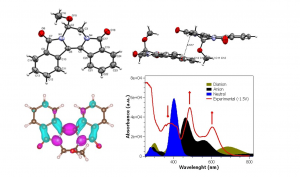
OptoElex – Novel Light-weight Pentacyclic amide Compounds for Optoelectronic applications
Small organic molecules for application as organic semiconductors (OSCs) principally as organic thin film transistors (OTFT) and OLEDs.
BACKGROUND
The development of novel and more efficient (opto)electronic devices has become the centre of much focus in both chemistry and materials science, due to the profound effect they have on our lives. In this context, there has been an increased focus on novel organic and flexible electronics. In general, organic semiconductors, when compared to traditional Si and GaAs-based technologies, offer unique features such as tunable electronic structure and physicochemical properties via core functionalization, mechanical flexibility as well as variable optical band gaps and ability to be solution processed on a large scale with low cost. The introduction of some deformability in the organic semiconductor is a relevant goal that permits for example the fabrication of flexible and printed electronic materials. Critical to this goal is the development of more efficient organic semiconductors (OSCs) integrating excellent charge transport with efficient light emission properties. Also the availability of the precursors used to make them and their cheapness is also a very important consideration.
TECHNOLOGY OVERVIEW
A series of novel lightweight pentacyclic imide compounds (See Figure 2) with interesting optoelectronic and electrochemical properties has been developed. These compounds showed very good electrochemical properties with energy gaps, like for example, 2,60 eV and 2,54 eV, in the case of one compound, indicating that they are suitable OSC compounds. The compounds showed reasonable fluorescence efficiency in solution. The preliminary tests on OLEDs based on these compounds suggested good optolectronic applications. Reorganization energy and carrier mobility calculations confirmed the suitability of both compounds as OSC active components with a slight predominance for n-type semiconductor behavior. A second generation series of these compounds is under development.Work is on-going on the synthesis of further derivatives with potentially superior optoelectronic properties, charge mobilities and on improving their stability.
STAGE OF DEVELOPMENT
Technology Readiness Level (TRL): 3/4.
The goals is the development of an efficient OTFT and/or OLED device in the next by 2024.
BENEFITS
Small, lightweight compounds obtained from renewable resources and cheaply made.
APPLICATIONS
- Semiconductor industry;
- Electronics industry;
- Telecommunications;
- Fine chemicals.
INTELLECTUAL PROPERTY
OPPORTUNITY
- Available for exclusive and non-exclusive licensing;
- Seeking co-development partners.
FURTHER DETAILS
Ambipolar Pentacyclic Diamides with Interesting Electrochemical and Optoelectronic Properties, Carolina S. Marques, Hugo Cruz, Simon E. Lawrence, Sandra Gago, João P. Prates Ramalho, Luís C. Branco, Anthony J. Burke, ChemComm. 2020, 14893 – 14896. https://pubs.rsc.org/en/content/articlelanding/2020/cc/d0cc04629a/unauth#!divAbstract https://doi.org/10.1039/D0CC04629A
Novas Moléculas Pequenas para Opto-eletrónica, Anthony J. Burke Ongoing, Química (Sociedade Portuguesa de Química). 2021, 45 (160), 26 (editor; Vasco Bonífacio).

Figure 1

Figure 2
NOVA Inventors
Luís Branco
Sandra Gago
Hugo Cruz


